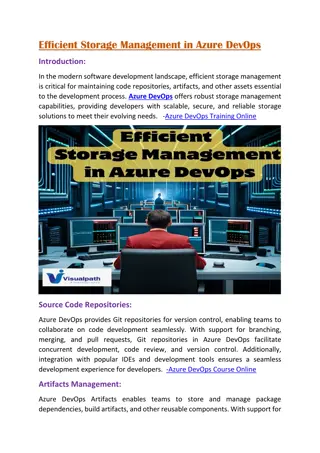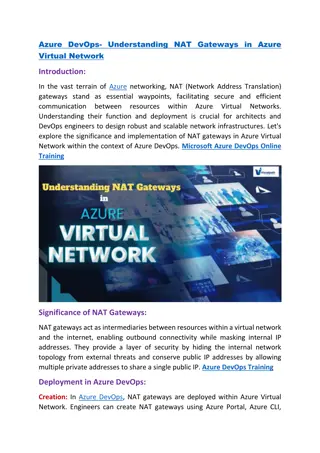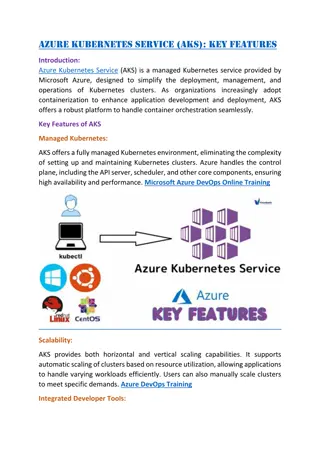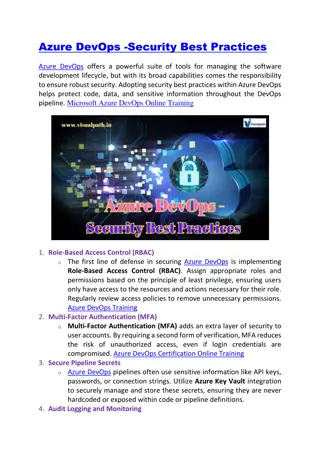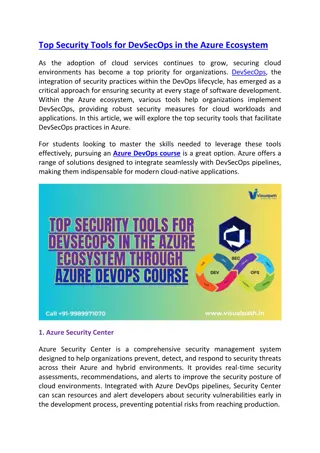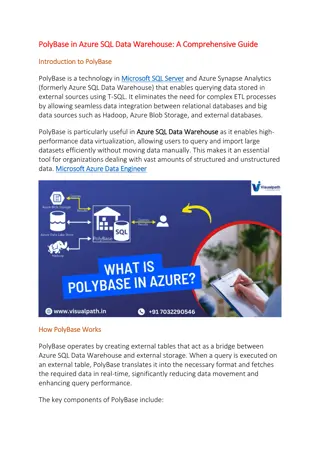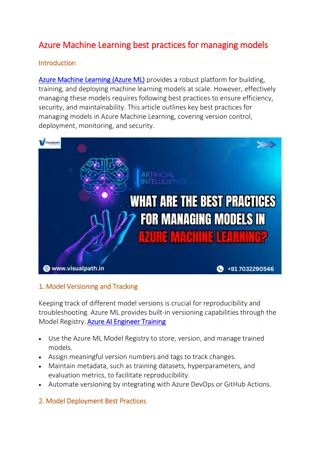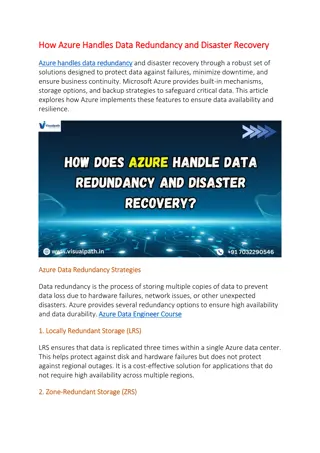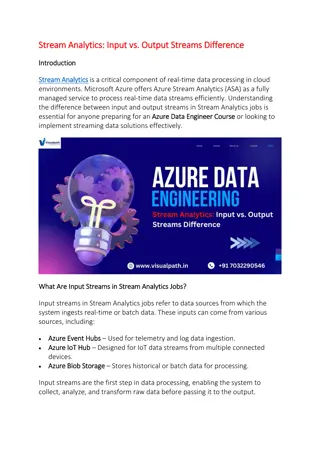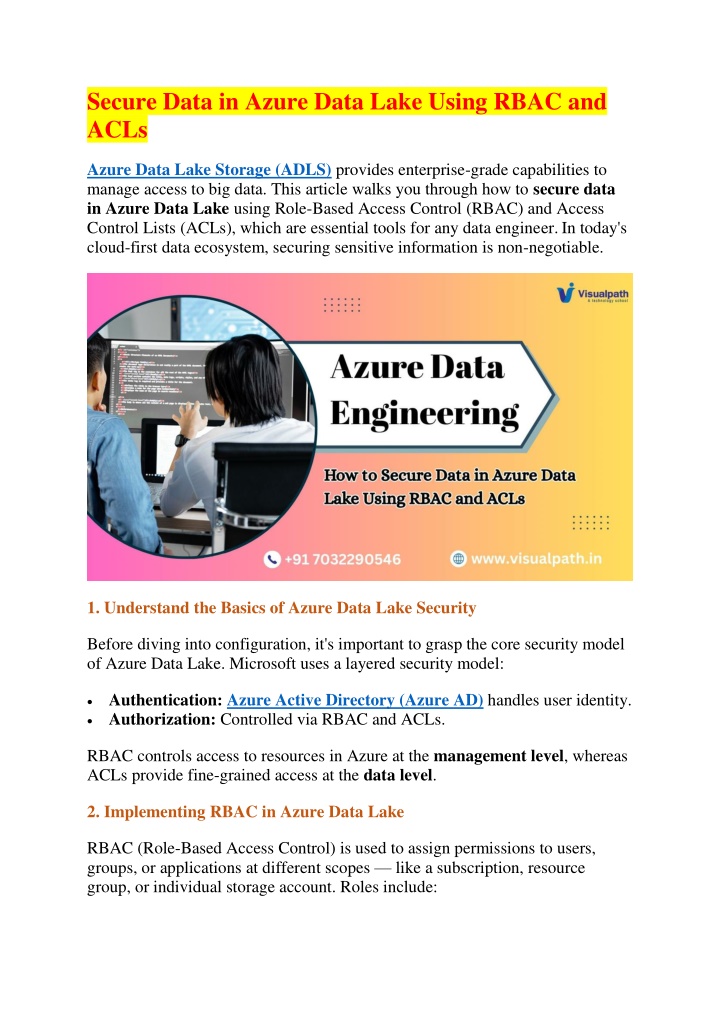
Azure Data Engineer Course | Azure Training in Hyderabad
Kickstart your tech career with VisualPathu2019s Azure Data Engineer Training in Hyderabad. Gain real-time skills through live projects, expert-led sessions, and flexible weekend batches. Our comprehensive Azure Data Engineer Course also offers life
Download Presentation

Please find below an Image/Link to download the presentation.
The content on the website is provided AS IS for your information and personal use only. It may not be sold, licensed, or shared on other websites without obtaining consent from the author. If you encounter any issues during the download, it is possible that the publisher has removed the file from their server.
You are allowed to download the files provided on this website for personal or commercial use, subject to the condition that they are used lawfully. All files are the property of their respective owners.
The content on the website is provided AS IS for your information and personal use only. It may not be sold, licensed, or shared on other websites without obtaining consent from the author.
E N D
Presentation Transcript
Secure Data in Azure Data Lake Using RBAC and ACLs Azure Data Lake Storage (ADLS) provides enterprise-grade capabilities to manage access to big data. This article walks you through how to secure data in Azure Data Lake using Role-Based Access Control (RBAC) and Access Control Lists (ACLs), which are essential tools for any data engineer.In today's cloud-first data ecosystem, securing sensitive information is non-negotiable. 1. Understand the Basics of Azure Data Lake Security Before diving into configuration, it's important to grasp the core security model of Azure Data Lake. Microsoft uses a layered security model: Authentication:Azure Active Directory (Azure AD) handles user identity. Authorization: Controlled via RBAC and ACLs. RBAC controls access to resources in Azure at the management level, whereas ACLs provide fine-grained access at the data level. 2. Implementing RBAC in Azure Data Lake RBAC (Role-Based Access Control) is used to assign permissions to users, groups, or applications at different scopes like a subscription, resource group, or individual storage account. Roles include:
Reader View resources only. Contributor Manage resources except granting access. Storage Blob Data Reader/Contributor/Owner Manage or read blob data. For someone pursuing a Azure Data Engineer Course Online, mastering RBAC is critical for enterprise-grade data security. 3. Using ACLs for Fine-Grained Control Access Control Lists (ACLs) offer a second layer of control by setting permissions at the folder and file level. Read (r) Write (w) Execute (x) Each file or directory has: An Access ACL (for direct access) A Default ACL (inherited by child items) 4. Step-by-Step: Configure RBAC and ACLs in ADLS 1.Assign RBAC Roles: oNavigate to your Data Lake resource in Azure Portal. oClick on "Access Control (IAM)". oAdd role assignments (e.g., "Storage Blob Data Contributor") to users/groups. 2.Verify Permissions: oUse az storage fs access show to confirm ACL settings. oAudit access logs via Azure Monitor. By combining RBAC and ACLs, you can ensure both broad and granular security controls over your data lake resources. 5. Best Practices for Securing Azure Data Lake Apply least privilege principle: Grant minimum necessary access. Use groups instead of individual users: Easier to manage and audit. Automate via templates/scripts: Ensures consistency across environments. Regularly audit access logs: Stay compliant and secure.
For professionals enrolled in Azure Data Engineer Training, these practices are core to becoming job-ready. 6. Common Pitfalls to Avoid Relying only on RBAC and ignoring ACLs. Over-assigning permissions (e.g., giving Contributor instead of Reader). Not auditing access patterns regularly. Using shared access keys instead of Azure AD. Understanding these gaps helps you design a more secure and scalable solution. 7. Real-World Scenario Example Imagine a financial services team needing access to raw transaction logs in /data/finance/raw. You can: Assign Storage Blob Data Reader at the storage level via RBAC. Set ACLs on the specific folder with read-only access for analysts and full control for data engineers. Professionals upskilling through Azure Data Engineer Training Online must grasp these security models to build robust, enterprise-ready solutions. Final Thoughts Securing Azure Data Lake using RBAC and ACLs is a fundamental skill in any cloud data engineer s toolkit. It helps safeguard sensitive business information while enabling team productivity. Whether you're designing a new data lake or auditing an existing one, these tools provide the flexibility and control you need. Trending Courses: Artificial Intelligence, Azure AI Engineer, SAP PaPM Visualpath stands out as the best online software training institute in Hyderabad. For More Information aboutthe Azure Data Engineer Online Training Contact Call/WhatsApp: +91-7032290546 Visit: https://www.visualpath.in/online-azure-data-engineer-course.html





